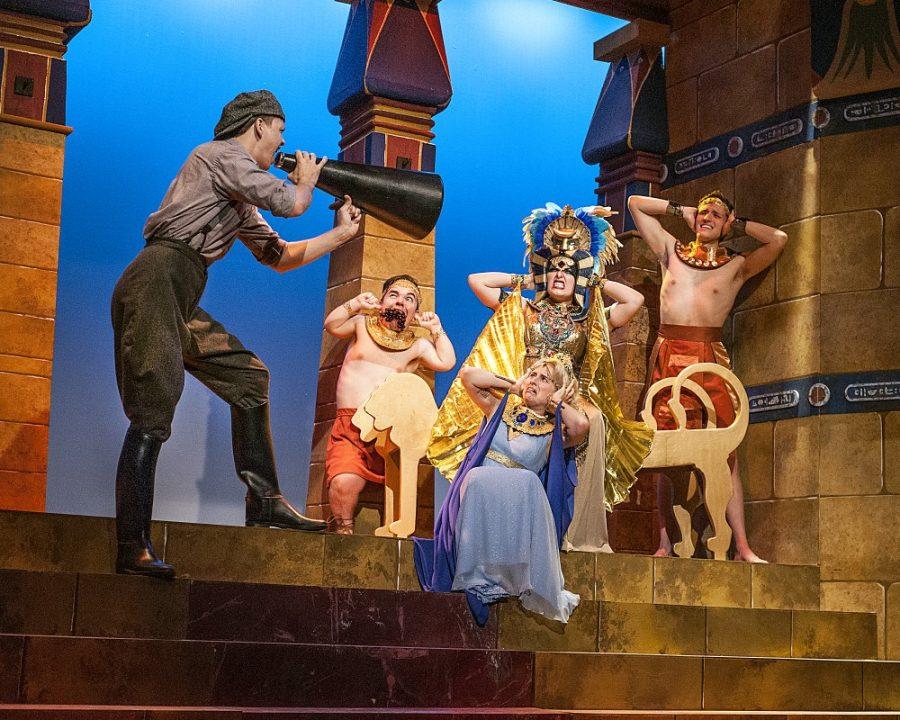Costume design wields a lot of power. The design team has an ability to dictate what the actor will wear and in some cases, what the actor will look like. Part of the job is taking a play or a musical and coming up with a new spin on a traditional piece, and may even require creating your own time period.
“The costume designer has to be sort of part historian, part designer and part psychologist,” said Patrick Holt, associate professor and head of the costume design program at the School of Theatre Film and Television.
Costume production and design students have a six-show season. Holt designs one or two of the shows for any one season, so the remaining shows are student-designed.
“From the very beginning, the director introduces us to their concept and their ideas about the play that they are doing,” Holt said. “Then we go back as designers and start to research.”
The time and setting of a performance are key in determining certain aspects of an actor’s costume.
“There’s a lot of filling in the blanks; most scripts don’t tell you ‘so-and-so walks in; she’s a 40-year-old white woman with white hair wearing green,”’ Holt said.
RELATED: Review: Arizona Repertory Theatre revives a classic to great success
Most of the time the designers have to decide what fits the play. They do not always get exact information about what a character is supposed to look like; Holt says that gives the costume designers and producers a lot of influence over an actor.
“We have to decide what’s most appropriate for that character,” he said. “Many times, [the actor] bases a lot of the character on what they see us design.”
One of those actors is Marissa Munter, a senior in the musical theatre program at the School of Theatre, Film and Television.
“Your clothes are a reflection of who you are, so wearing those clothes really help you tie into the mannerisms of those characters,” Munter said.
According to Holt, a design of a character on a sheet of paper can have a huge impact on who ends up getting a certain role in a production.
“I’ll interpret the character a certain way … what I end up drawing on the page often times ends up what’s being cast,” he said.
When Holt makes his drafts, he might imagine a character being a certain height or having a certain build. He said that in many ways he feels that what he draws may be the best interpretation of that character for a particular performance. However, Holt has to be flexible and open to vastly different interpretations.
“Many times it’s the complete opposite; I’ll draw a six-foot, size two white woman and they end up with someone else who’s not that size and not that shape and that means I have to go back and redesign,” he said.
One such incident occurred when Munter was supposed to play a blonde bombshell, Marilyn Monroe-type of character — someone she said she looks nothing like.
“I had to talk to the customers a lot about how we could create that illusion with the costume, which was helpful,” she said.
The costume designers have hundreds of costumes in stock that are ready for use, but they will make new costumes if the need arises. Often the actors will be fitted in muslin, a cheaper fabric, just to get a rough idea of what a costume will look like, before work begins on the costume the actor will actually wear on stage.
RELATED: Review: “Rent” struggles at times, but power of love pulls through
“I don’t think people realize just how expensive it can be,” Holt said. “Just the fabric alone … if there’s a dress that needs 12 yards of fabric, and the fabric costs $35 a yard, it starts to get very expensive.”
The cost of producing a costume is increased once accessories like zippers and trims are added. But all the extra work pays off for the actors and actresses wearing the costumes.
“To me, it’s like that final touch, that final emersion into the world that you are trying to create … once you get those clothes on you really start to feel like that character you are trying to portray,” Munter said.
Follow Daily Wildcat on Twitter









